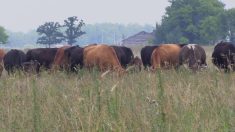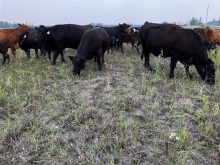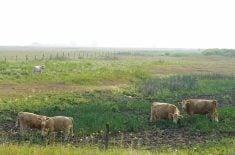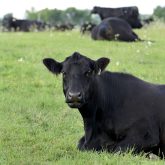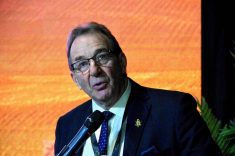A field down the road from Calvin Reykdal’s farm has two swaths taken out. The rest is still standing, only a couple of inches higher than the cut section. That was first cut, not worth the fuel and time to take it off the field.
It’s one of many fields like that in the RM of West Interlake — barely growing high enough to hit the mower bar all summer.
Why it matters: If Interlake and Parkland producers are forced to sell cattle to survive, market saturation and herd reduction will hurt the Manitoba beef industry. Ranching is also a major economic driver in the region.
“You’ve got basically every generation saying that they’ve never seen it like this before,” Reykdal said. He ranches about 600 cows near Vogar with his nephew Brad Reykdal.
“We’ll see how many are left next spring.”
The area is greening up now after rains in the last week of August, but every stone is still visible in the bald pastures and the growing season is nearly over.
Reykdal said he has about a sixth of a hay crop this year. One field that should have produced 400 bales yielded about 15 bales.

“This one’s gonna hurt,” Reykdal said, pausing before adding “a lot.”
On Aug. 29, 12 municipalities in the Interlake and Parkland region declared a state of agricultural disaster due to severe dry conditions.
They cited severely reduced hay crops and pasture growth which have forced ranchers to go long distances to buy feed.
In a release, the municipalities asked the province to start discussions with the federal government to assess the situation under the AgriRecovery framework, and that a program be initiated to provide immediate feed and freight assistance and compensation for drilling new wells to get water to livestock.
AgriRecovery is a joint province-federal framework for disaster relief, particularly for “extraordinary costs” producers take on to recover from disasters.
Read Also
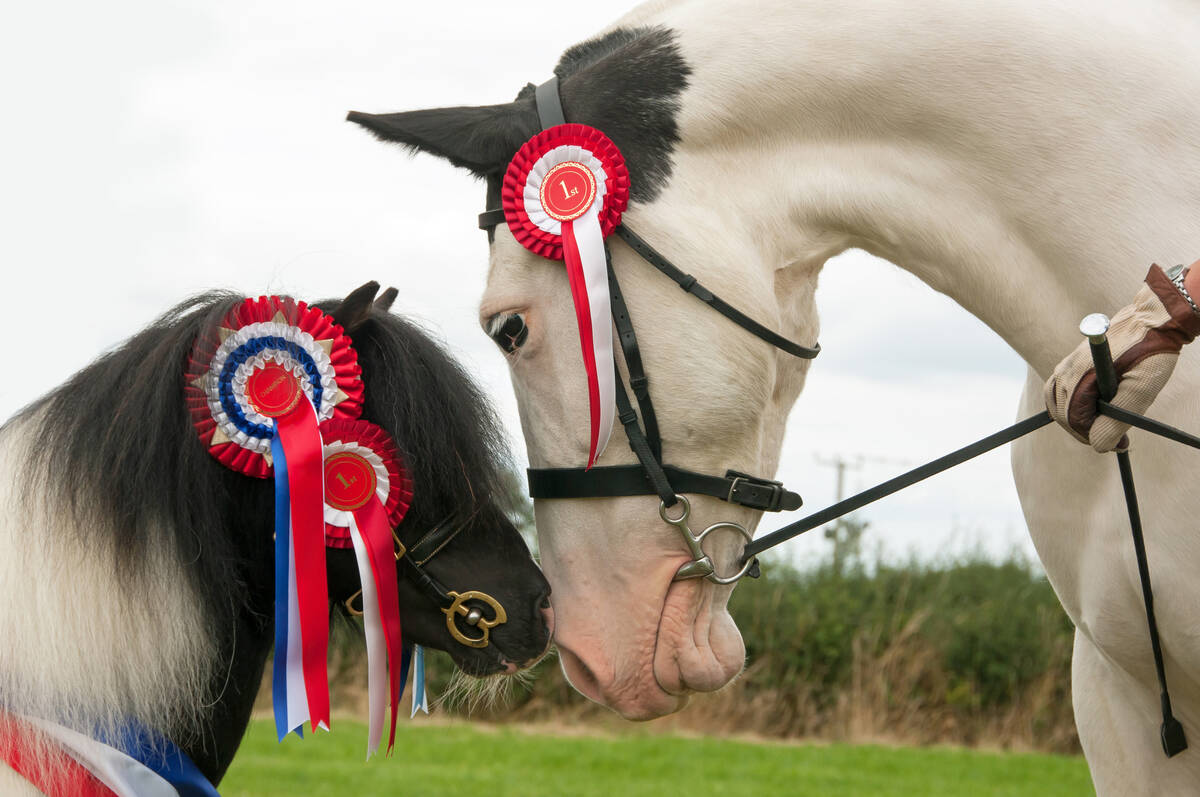
Linebreeding horses drives genetic bottlenecks
Too much linebreeding and prioritizing pedigree can narrow genetic diversity and lead to horse health problems in future generations.
Federal blackout as well?
When the Co-operator visited West Interlake on Sept. 3, producers and Reeve Art Jonasson expressed concern that because of the provincial election, no one would come to their aid.
Jonasson said he’d been told repeatedly by incumbent MLA Derek Johnson and by Agriculture Minister Ralph Eichler that they couldn’t make announcements because of the provincial election.
“Yeah, but you can make a promise,” said Jonasson.
“If there was a disaster, if there was a tornado touchdown, and there was a huge disaster, people killed and things, some bureaucracy somewhere would be able to say ‘OK yes, this is what we’re going to do,’” said Jonasson, who is also a rancher.
“We haven’t heard from our government,” said Teresa Johnson, who raises cattle with husband Greg Johnson.
What hope was given appeared contingent on the outcome of the provincial election.
On Sept. 4, Agriculture Minister Eichler told the Co-operator that he had a meeting booked with the federal agriculture minister for the day after the election and indicated he’d ask the federal government for clearance to begin assessments for the AgriRecovery framework.
He said he had two other recovery projects he was prepared to announce after the election.
“I know that seems like eternity when you’re waiting,” Eichler said. “My heart goes out to all farm families.”

Eichler expressed concern that he would have a small window to speak to federal Minister of Agriculture Marie-Claude Bibeau before the federal election period begins and she is under an election blackout.
He’s optimistic, but doesn’t want to mislead, Eichler said. If the AgriRecovery program is triggered, it will take time to pay out.
“Don’t give up hope. We’re paying attention. We’re really paying attention.”
(This article was published in the Sept. 12, 2019 issue of the Manitoba Co-operator that went to print prior to the election.)
Not the first disaster
Producers seemed reluctant to be too optimistic, however.
In 2011, Lake Manitoba flooded to historic levels, killing trees, stranding cattle and rendering hay land useless. The land flooded again in 2014.
“A lot of guys can’t take any more,” said Jonasson.
“We’re still cleaning up from the flood,” said Reykdal, who said they’re still finding trees washed up from the lake in the bottoms of their sloughs. This proves a hazard to their haying equipment.
Jonasson and Reykdal recalled that the AgriRecovery framework was triggered then too. They said they were told the province knew they were in for a multi-year recovery.
Ranchers they knew racked up huge bills hauling in feed. Then when winter of 2012 came, “it was silent,” Reykdal said. AgriRecovery didn’t pay out any more.
“AgriRecovery is not intended to pay for the same event more than once. AgriRecovery was never intended to provide long-term compensation for situations that have affected the production capacity of a region for extended periods,” an Agriculture and Agri-Food Canada department official said in an emailed statement, the Co-operator reported in 2013.
Farmers protested by blocking the opening of the Portage Diversion in 2013 and took to the steps of the Manitoba legislature to voice their displeasure with the province’s handling of compensation in 2011 and 2012.
The province responded that long-term compensation was an issue that needed federal support.
In 2011, Greg and Teresa Johnson’s house was barricaded behind two dikes. Today, oak trees killed by the flood still dot the yard and will have to be cut down.
“Which is heartbreaking,” Teresa said.
Selling your factory at a loss
Jonasson said he thought if something wasn’t done in the next two weeks, people would have to make a decision — buy feed or sell cows. The straw, what there is of it down south, won’t wait for them.
Johnson said he hadn’t decided how to weather the winter. He’ll keep trying to make feed and hope for assistance.
“It’s just a shame,” he said. He said he has built up his herd’s genetics for years, and now he faces selling cows worth a couple of thousand dollars for meat. Johnson has 300 cow-calf pairs.
“You can’t really replace them right away,” Johnson said. “You’re selling your factory at a loss.”
Teresa Johnson said their teenage son Cole would like to work on the farm after he graduates and take it over someday. He’d be the third generation to ranch that land.
Ranching is the only industry in the Vogar area, Jonasson said. He’s worried that if the area loses its cows, young families will have to leave, shrinking small towns and schools.
There aren’t many options — Vogar barely has a post office, never mind businesses. The kids go to school in Ashern, about 45 kilometres away.
Jonasson said larger ranchers might have to sell 30 to 40 per cent of their herd. They’d have income, but take years to recover.
For those with debt, “they’ll just go deeper and deeper and deeper,” Jonasson said. Small producers may have to sell off entirely. Jonasson said he’s seen whole herds up for sale.
“It’s a full-blown hit,” he said.
The Reykdals and Johnsons have been cutting the bottoms of sloughs and baling bulrushes for straw. It’s little more than filler and will have to be heavily supplemented with grain and protein.
Reykdal feeds 25 bales a day in the winter. These days, hay bales can go for $100 or more, he said. Jonasson said straw bales were selling for $35 a bale.
Jonasson said hay selling has become a “blood sport” with price gouging. Reykdal said he saw someone posting hay for $240 per bale on a hay-selling website. The seller got shouted down in the comments and deleted the post.
“Disasters bring out the best and worst in people,” Jonasson said. “There are people who are giving straw away.”
Business risk management friend or foe?
On Aug. 29, the group of 12 municipalities asked the province to prioritize a meeting with beef producers and stakeholders to talk about the shortfalls of existing business risk management programs.
During discussion with ranchers near Vogar, the Manitoba Co-operator heard about the shortfalls of these programs, including forage insurance, AgriStability and livestock price insurance.
Through MASC, producers can buy ‘select’ hay insurance, which insures against quality and production shortfall individually for five types or hay, according to the MASC website. Producers can also choose ‘basic’ hay insurance, which is whole-farm forage insurance on all five hay types.
MASC says both packages include the Hay Disaster Benefit which “compensates forage producers for the increased costs of hay and transportation when there is a severe province-wide forage shortfall.”
Calvin Reykdal said he has no forage insurance because it doesn’t work for him.
“We’ve been screwed so many times on hay insurance,” he said.
Art Jonasson said he doesn’t know many producers in his area with forage insurance. In 2014 his ranch was short 600 to 700 bales and he didn’t qualify for payment, he said.
Tom Teichroeb, president of the Manitoba Beef Producers, said that for hayfields that have a high percentage of alfalfa, forage insurance responds well. For those like Reykdal who hay a 50-50 mix of alfalfa and grasses, the program has not responded as well.
“There’s pieces that work and there are pieces that do not,” he said.
Reykdal said that last year, which was also dry, he had to buy a lot of feed and yet he did not qualify for AgriStability.
The AgriStability program is designed to pay out when producers experience a large margin decline. If a producer’s margin falls to 70 per cent of their reference margin (based on a five-year “Olympic” average), they may qualify for payment.
The 70 per cent margin has been criticized by producer and commodity groups since it was reduced from 85 per cent in 2013.
“If AgriStability doesn’t kick in this year, then what’s the point?” Reykdal said. “And I don’t know that it will.”
Teichroeb said AgriStability works well for feedlot operators but doesn’t favour cow-calf producers.
Reykdal and Jonasson said that while livestock price insurance is available, this can’t compensate for the enormous input costs going into each animal.




